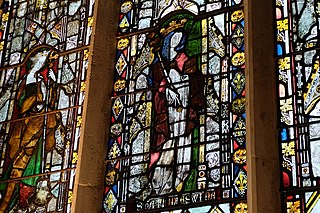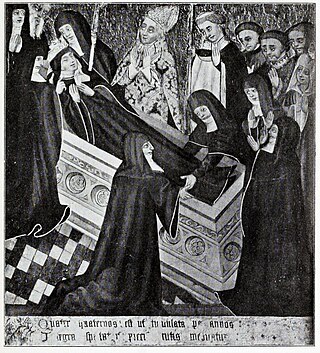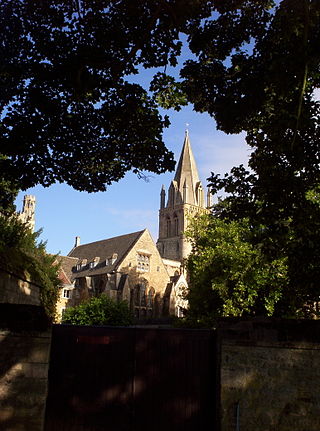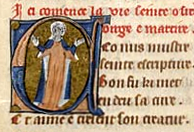William de Corbeil or William of Corbeil was a medieval Archbishop of Canterbury. Very little is known of William's early life or his family, except that he was born at Corbeil, south of Paris, and that he had two brothers. Educated as a theologian, he taught briefly before serving the bishops of Durham and London as a clerk and subsequently becoming an Augustinian canon. William was elected to the See of Canterbury as a compromise candidate in 1123, the first canon to become an English archbishop. He succeeded Ralph d'Escures who had employed him as a chaplain.

Shaftesbury Abbey was an abbey that housed nuns in Shaftesbury, Dorset. It was founded in about 888, and dissolved in 1539 during the English Reformation by the order of Thomas Cromwell, minister to King Henry VIII. At the time it was the second-wealthiest nunnery in England, behind only Syon Abbey.

Bierton is a village and civil parish in Buckinghamshire, England, about half a mile northeast of the town of Aylesbury. It is mainly a farming parish. Together with the hamlets of Broughton, Kingsbrook, Broughton Crossing and Burcott it historically formed the civil parish of Bierton with Broughton within Aylesbury Vale district and form part of the Aylesbury Urban Area, but in 2020 the parish was broken into three, with Bierton becoming its own parish.

Frithuswith, commonly Frideswide, was an English princess and abbess. She is credited as the foundress of a monastery later incorporated into Christ Church, Oxford. She was the daughter of a sub-king of a Mercia named Dida of Eynsham whose lands occupied western Oxfordshire and the upper reaches of the River Thames.

St Osyth is an English village and civil parish in the Tendring District of north-east Essex, about 5 miles (8.0 km) west of Clacton-on-Sea and 12 miles (19.3 km) south-east of Colchester. It lies on the B1027, Colchester–Clacton road. The village is named after Osgyth, a 7th-century saint and princess. Locally, the name is sometimes pronounced "Toosey". It is claimed to be the driest recorded place in the United Kingdom.

Eadburh of Bicester was an English nun, abbess, and saint from the 7th century. She has been called a "bit of a mystery"; there have been several Saxon saints with the same name, so it is difficult to pinpoint which one was Eadburh. It is most likely that Eadburh of Bicester was the daughter of King Penda of Mercia, who was pagan but had several children who were Christians. Eadburgh was born in Quarrendon. Her sister was Edith, with whom she co-founded an abbey near Aylesburg; Eadburh probably became abbess at Aylesburg. She was also aunt of Osgyth, whom she trained "in the religious life". There are legends that claim that Edburgh and Edith found Osyth after she had drowned three days earlier and "witnessed her return to life".

Seaxburh, also Saint Sexburga of Ely, was a Queen as well as an abbess, and is a saint of the Christian Church. She was married to King Eorcenberht of Kent.

Saint Mildburh was the Benedictine abbess of Wenlock Priory. Her feast day is 23 February.

St. Botolph's Priory was a medieval house of Augustinian canons in Colchester, Essex, founded c. 1093. The priory had the distinction of being the first and leading Augustinian convent in England until its dissolution in 1536.
Frithuwald was a seventh-century Anglo-Saxon ruler in Surrey, and perhaps also in modern Berkshire and Buckinghamshire, who is known from two surviving charters. He was a sub-king ruling under King Wulfhere of Mercia. According to late hagiographical materials, he was a brother-in-law of Wulfhere. The monks of Saint Peter's Minster, Chertsey, revered Frithuwald, whom they considered the founder of their monastery, as a saint.
Amesbury Abbey was a Benedictine abbey of women at Amesbury in Wiltshire, England, founded by Queen Ælfthryth in about the year 979 on what may have been the site of an earlier monastery. The abbey was dissolved in 1177 by Henry II, who founded in its place a house of the Order of Fontevraud, known as Amesbury Priory.

St Frideswide's Priory was established as a priory of Augustinian canons regular, in 1122. The priory was established by Gwymund, chaplain to Henry I of England. Among its most illustrious priors were the writers Robert of Cricklade and Philip of Oxford.
Saint Edith of Polesworth is an obscure Anglo-Saxon abbess associated with Polesworth (Warwickshire) and Tamworth (Staffordshire) in Mercia. Her historical identity and floruit are uncertain. Some late sources make her a daughter of King Edward the Elder, while other sources claim she is the daughter of Egbert of Wessex. Her feast day is 15 July.

Modwenna, or Modwen, was a nun and saint in England, who founded Burton Abbey in Staffordshire in the 7th century.
Saint Eanswith, also spelled Eanswythe or Eanswide, was an Anglo-Saxon princess, who is said to have founded Folkestone Priory, one of the first Christian monastic communities for women in Britain. Her possible remains were the subject of research, published in 2020.
Repton Abbey was an Anglo-Saxon Benedictine abbey in Derbyshire, England. Founded in the 7th century, the abbey was a double monastery, a community of both monks and nuns. The abbey is noted for its connections to various saints and Mercian royalty; two of the thirty-seven Mercian Kings were buried within the abbey's crypt. The abbey was abandoned in 873, when Repton was overrun by the invading Great Heathen Army.

St Osyth's Abbey was a house of Augustinian canons in the parish of St Osyth in Essex, England in use from the 12th to 16th centuries. Founded by Richard de Belmeis, Bishop of London, c. 1121, it became one of the largest religious houses in Essex. It was dedicated to Saints Peter and Paul as well as St Osyth (Osith), a royal saint and virgin martyr. Bishop Richard obtained the arm bone of St Osyth from Aylesbury for the monastic church and granted the canons the parish church of St Osyth.
Osburh was an Anglo-Saxon saint who rested at Coventry Cathedral. Although there is some tradition holding her to be an early 11th-century abbess of Coventry Abbey, it is suspected that her cult predates the Viking Age.
Eadgyth of Aylesbury also known as Eadridus was a Dark Ages Catholic saint from Anglo-Saxon England.












